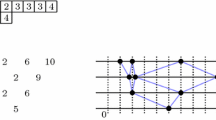Abstract
Joyce trees have concrete realizations as J-trees of sequences of 0’s and 1’s. Algorithms are given for computing the number of minimal height J-trees of d-ary sequences with n leaves and the number of them with minimal parent passing numbers to obtain polynomials ρ n (d) for the full collection and α n (d) for the subcollection.
The number of traditional Joyce trees is the tangent number α n (1); α n (2) is the number of cells in the canonical partition by Laflamme, Sauer and Vuksanovic of n-element subsets of the infinite random (Rado) graph; and ρ n (2) is the number of weak embedding types of rooted n-leaf J-trees of sequences of 0’s and 1’s.
Similar content being viewed by others
References
Denis C. Devlin: Some partition theorems and ultrafilters on ω, Ph.D. thesis, Dartmouth College, 1979.
Paul Erdős, András Hajnal and Lajos Pósa: Strong embeddings of graphs into colored graphs, Colloquia Mathematica Societatis János Bolyai, 10, Vol. I, Infinite and Finite Sets, 585–595.
Paul Erdős and Richard Rado: A combinatorial theorem, J. London Math. Soc. 25(2) (1950), 249–255.
Ronald L. Graham, Donald K. Knuth and Oren Patashnik: Concrete Mathematics, Addison-Wesley Publishing Company, New York, 1989.
Claude Laflamme, Norbert W. Sauer and Vojkan Vuksanovic: Canonical partitions of universal structures, Combinatorica 26(2) (2006), 183–205.
Keith R. Milliken: A Ramsey theorem for trees, J. Combin. Theory Ser. A 26 (1979), 215–237.
George N. Raney: Functional composition patterns and power series reversion, Trans. Amer. Math. Soc. 94 (1960), 441–451.
Norbert W. Sauer: Edge partitions of the countable triangle free homogeneous graph, Discrete Mathematics 185 (1998), 137–181.
Norbert W. Sauer: Appendix in: Theory of Relations, revised edition, by Roland Fraïssé, Studies in Logic and the Foundations of Mathematics, 145, North Holland, 2000.
Norbert W. Sauer: Coloring subgraphs of the Rado graph, Combinatorica 26(2) (2006), 231–253.
N. J. A. Sloane: The On-Line Encyclopedia of Integer Sequences, http://www.research.att.com/:_njas/sequences/
Richard P. Stanley: Enumerative Combinatorics, Volume 2, Cambridge University Press, Cambridge, 1999.
Ross Street: Trees, permutations and the tangent function; Reflections 27(2) (Math. Assoc. of New South Wales, May 2002), 19–23.
Vojkan Vuksanovic: A combinatorial proof of a partition relation for [ℚ]n, Proc. Amer. Math. Soc. 130(10) (2002), 2857–2864.
Vojkan Vuksanovic: Canonical equivalence relations on ℚn, Order 20(4) (2003), 373–400.
Vojkan Vuksanovic: Infinite partitions of random graphs, J. Combin. Theory Ser. A 113(2) (2006), 225–250.
Author information
Authors and Affiliations
Corresponding author
Additional information
The author thanks the University of Tel Aviv for hospitality in April 2004 when much of this work was done.




